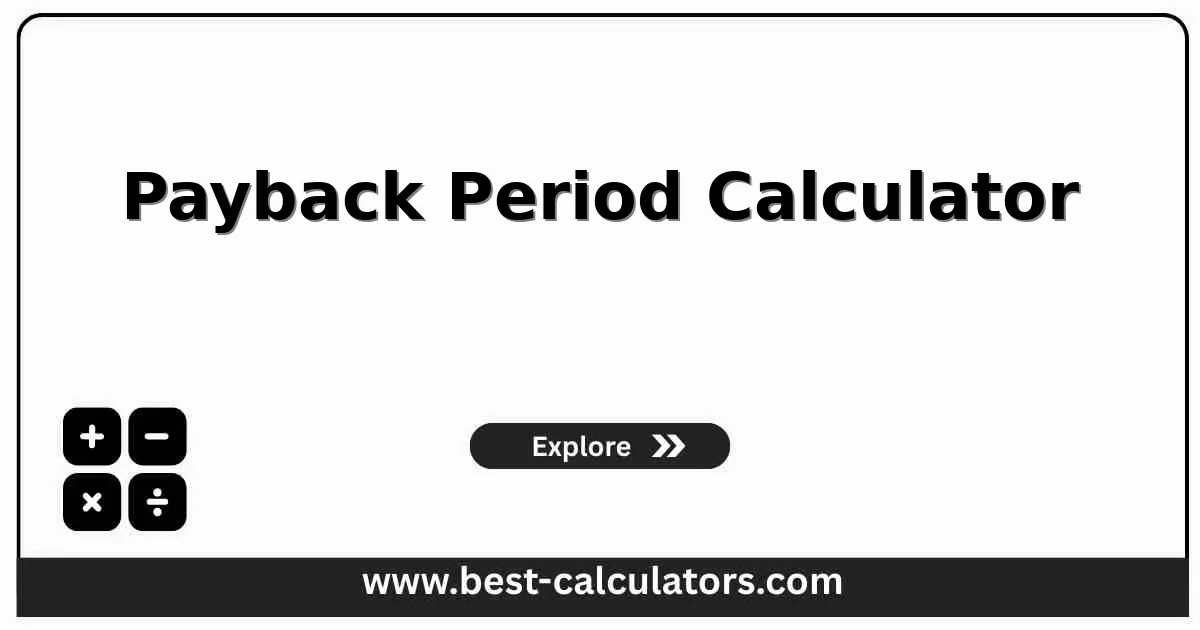Payback Period Calculator - Calculate ROI Timeline
Free payback period calculator to determine investment recovery time. Calculate breakeven point, ROI timeline, and project profitability with instant results
Payback Period Calculator
Results
What is a Payback Period Calculator?
A payback period calculator is a free financial tool that helps you determine how long it takes to recover an initial investment through cash flows. It calculates the time needed to reach the breakeven point where cumulative cash inflows equal the initial investment outlay.
This calculator helps with:
- Investment decisions - Evaluate project profitability and risk
- Capital budgeting - Compare multiple investment opportunities
- Equipment purchases - Determine machinery ROI timeline
- Business projects - Assess new venture viability
- Financial planning - Make informed resource allocation decisions
To evaluate investment profitability beyond just payback period, you can use our ROI calculator to calculate the complete return on investment percentage for your projects.
For more advanced investment analysis, explore our IRR calculator to determine the internal rate of return and compare different investment opportunities effectively.
If you're planning long-term investments, our investment calculator can help you project future values and growth rates over extended time periods.
How Payback Period Works
The payback period calculation measures investment recovery time using proven formulas:
Simple Payback Period Formula
Example: $50,000 investment with $12,000 annual cash flow:
Discounted Payback Period Formula
Sum discounted cash flows year by year until cumulative total equals or exceeds the initial investment. This method accounts for the time value of money and provides a more accurate recovery timeline.
Key Concepts
Simple vs Discounted Payback
Simple payback ignores time value of money and is faster to calculate. Discounted payback applies a discount rate to future cash flows, providing a more conservative and accurate estimate that accounts for inflation and opportunity cost.
Breakeven Point
The breakeven point is when cumulative cash inflows equal the initial investment. This marks the transition from net negative to net positive cash position, indicating when the investment starts generating profit.
Time Value of Money
Money today is worth more than the same amount in the future due to earning potential. The discounted payback method incorporates this principle by reducing the value of future cash flows based on the discount rate.
How to Use This Calculator
Enter Initial Investment
Input the total upfront cost of your project or investment (e.g., $50,000)
Enter Annual Cash Flow
Input expected yearly cash inflows from the investment (e.g., $12,000)
Set Discount Rate
Optional: Enter your discount rate to calculate time value of money (e.g., 8%)
Choose Calculation Method
Check the box if you want to calculate discounted payback period
View Results
See payback period in years and months, plus ROI metrics
Analyze Investment
Compare results with industry benchmarks and make informed decisions
Benefits of Using This Calculator
- • Quick Risk Assessment: Instantly determine how long your capital is at risk and when you'll recover your investment.
- • Compare Opportunities: Evaluate multiple investment options side-by-side to choose the most profitable projects.
- • Cash Flow Planning: Understand when investments will start generating positive returns for better financial planning.
- • Accurate Analysis: Choose between simple and discounted methods based on your analysis needs.
- • Professional Insights: Get comprehensive metrics including ROI, breakeven year, and annual return rates.
Factors That Affect Payback Period
1. Initial Investment Size
Higher upfront costs = Longer payback period. Large investments take more time to recover, increasing financial risk and capital exposure.
2. Annual Cash Flow
Higher cash inflows = Shorter payback period. Strong revenue generation accelerates investment recovery and improves profitability.
3. Discount Rate
Higher discount rate = Longer discounted payback. Reflects opportunity cost and inflation, providing more conservative estimates.
4. Cash Flow Consistency
Stable, predictable cash flows lead to more accurate payback calculations. Variable cash flows require more complex analysis.

Frequently Asked Questions (FAQ)
Q: What is payback period?
A: Payback period is the time it takes for an investment to generate enough cash flow to recover the initial investment cost. It's measured in years and months, helping businesses evaluate how quickly they can recoup their investment.
Q: What's a good payback period?
A: A good payback period is typically 3-5 years or less. Shorter periods mean faster investment recovery and lower risk. However, the ideal payback period varies by industry and project type.
Q: Simple vs discounted payback period?
A: Simple payback period doesn't account for time value of money, while discounted payback period applies a discount rate to future cash flows. Discounted payback provides a more accurate measure by considering inflation and opportunity cost.
Q: How do you calculate payback period?
A: For simple payback: divide initial investment by annual cash flow. For uneven cash flows, add up cash flows year by year until they equal the initial investment. The discounted method applies a discount rate to each year's cash flow before calculating.